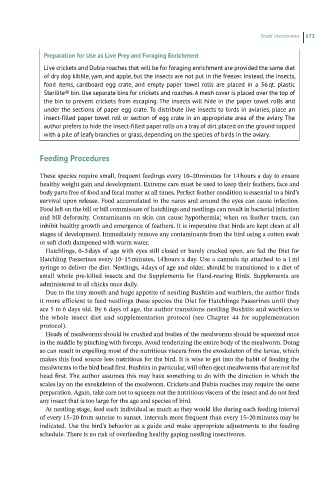Page 672 - Hand rearing birds second
P. 672
Small Insectivores 673
Preparationfor Useas LivePreyand ForagingEnrichment
Live crickets and Dubia roaches that will be for foraging enrichment are provided the same diet
of dry dog kibble, yam, and apple, but the insects are not put in the freezer. Instead, the insects,
food items, cardboard egg crate, and empty paper towel rolls are placed in a 56 qt. plastic
Sterilite® bin. Use separate bins for crickets and roaches. A mesh cover is placed over the top of
the bin to prevent crickets from escaping. The insects will hide in the paper towel rolls and
under the sections of paper egg crate. To distribute live insects to birds in aviaries, place an
insect-filled paper towel roll or section of egg crate in an appropriate area of the aviary. The
author prefers to hide the insect-filled paper rolls on a tray of dirt placed on the ground topped
with a pile of leafy branches or grass, depending on the species of birds in the aviary.
Feeding Procedures
These species require small, frequent feedings every 10–20 minutes for 14 hours a day to ensure
healthy weight gain and development. Extreme care must be used to keep their feathers, face and
body parts free of food and fecal matter at all times. Perfect feather condition is essential to a bird’s
survival upon release. Food accumulated in the nares and around the eyes can cause infection.
Food left on the bill or bill commissure of hatchlings and nestlings can result in bacterial infection
and bill deformity. Contaminants on skin can cause hypothermia; when on feather tracts, can
inhibit healthy growth and emergence of feathers. It is imperative that birds are kept clean at all
stages of development. Immediately remove any contaminants from the bird using a cotton swab
or soft cloth dampened with warm water.
Hatchlings, 0–3 days of age with eyes still closed or barely cracked open, are fed the Diet for
Hatchling Passerines every 10–15 minutes, 14 hours a day. Use a cannula tip attached to a 1 ml
syringe to deliver the diet. Nestlings, 4 days of age and older, should be transitioned to a diet of
small whole pre‐killed insects and the Supplements for Hand‐rearing Birds. Supplements are
administered to all chicks once daily.
Due to the tiny mouth and huge appetite of nestling Bushtits and warblers, the author finds
it more efficient to feed nestlings these species the Diet for Hatchlings Passerines until they
are 5 to 6 days old. By 6 days of age, the author transitions nestling Bushtits and warblers to
the whole insect diet and supplementation protocol (see Chapter 44 for supplementation
protocol).
Heads of mealworms should be crushed and bodies of the mealworms should be squeezed once
in the middle by pinching with forceps. Avoid tenderizing the entire body of the mealworm. Doing
so can result in expelling most of the nutritious viscera from the exoskeleton of the larvae, which
makes this food source less nutritious for the bird. It is wise to get into the habit of feeding the
mealworms to the bird head first. Bushtits in particular, will often eject mealworms that are not fed
head first. The author assumes this may have something to do with the direction in which the
scales lay on the exoskeleton of the mealworm. Crickets and Dubia roaches may require the same
preparation. Again, take care not to squeeze out the nutritious viscera of the insect and do not feed
any insect that is too large for the age and species of bird.
At nestling stage, feed each individual as much as they would like during each feeding interval
of every 15–20 from sunrise to sunset. Intervals more frequent than every 15–20 minutes may be
indicated. Use the bird’s behavior as a guide and make appropriate adjustments to the feeding
schedule. There is no risk of overfeeding healthy gaping nestling insectivores.

